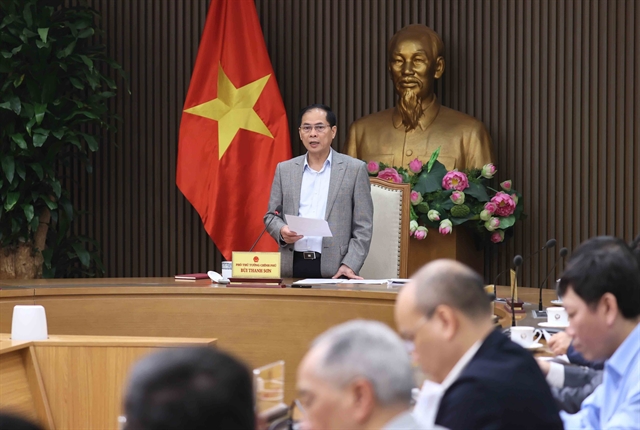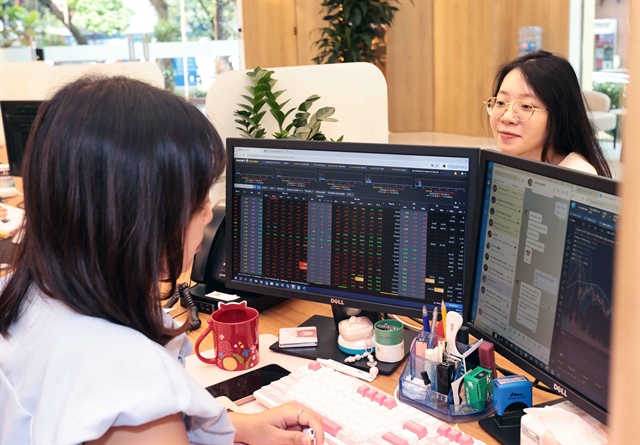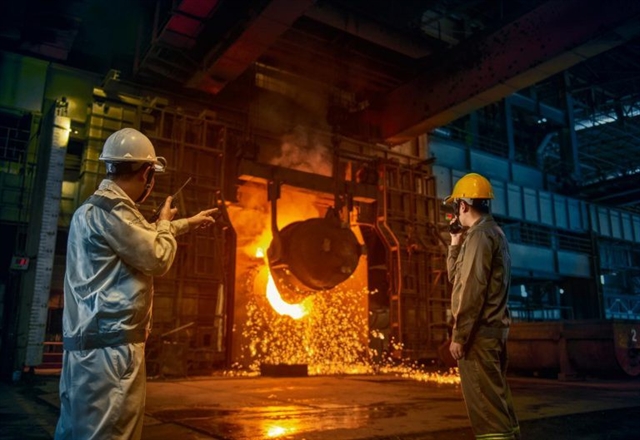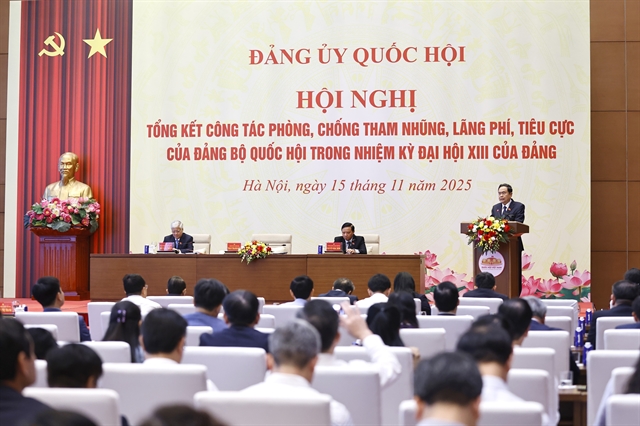 Economy
Economy

 |
| An investor watch the market's movements on her computer. — VNA/VNS Photo |
HÀ NỘI — As the global trading environment becomes increasingly hostile, exemplified by recent tariff hikes by US President Donald Trump, investors find themselves at a critical period in 2025.
The ongoing trade war, notably marked by the US imposing an astonishing 46 per cent tariff on numerous Vietnamese exports, has sent shockwaves through financial markets.
The domestic market's benchmark VN-Index closed Tuesday at 1,132.79 points, down 77.88 points, with over 250 ticker symbols on the southern bourse hitting bottom prices.
This development forces investors to look again at their portfolios and strategies as the landscape shifts beneath them.
In this climate of uncertainty, the imperative for investors is to remain composed and strategically agile, rather than succumbing to panic-driven decisions.
Analysts widely advocate that investors should redirect their focus towards robust companies with strong fundamentals—corporations that possess the capacity to withstand the economic storm brought forth by trade disputes.
Analysts from Saigon - Hanoi Securities JSC (SHS) see a prevailing sense of caution within the market.
The complexities of the global economic dynamics in 2025 highlight Việt Nam's emergence as a pivotal player in the restructuring of global supply chains. However, the increased trade surpluses simultaneously create pressure for necessary adjustments.
Such complexities indicate that the challenges posed by tariffs are not only about policy discussions, but also serve as a critical test for the country's economic resilience and adaptability.
SHS has pointed out the pressing uncertainty surrounding potential shifts in US trade policies under President Trump’s administration, now termed 'Trump 2.0.' This spectre of instability weighs heavily on investor sentiment, casting a shadow over the economic outlook.
According to the Director of the SHS Research Center, Nguyễn Minh Hạnh, the phrase 'Timing is Everything' succinctly encapsulates the essence of investment strategy for 2025.
Long-term investors often place less emphasis on timing. However, amid the current market conditions, a more short-term, proactive approach is warranted to navigate the choppy waters ahead.
As the VN-Index approaches potential turbulence, investors are strongly advised to steer clear of underperforming stocks.
Đỗ Bảo Ngọc, Vice General Director of Vietnam Construction Securities JSC, points out five promising sectors that are forecast to show robust profits in the first quarter of 2025. These sectors, including retail, technology and domestic banking, are viewed as safer havens for investors seeking to mitigate risk during these uncertain times.
The high tariffs are likely to hit exporters hard in textiles, leather, wood, steel and electronics - vital components of Việt Nam’s economy.
Analysts project that this development may compel Việt Nam to renegotiate trade balances and enhance bilateral negotiations with the US to alleviate the adverse economic impact of steep tariffs.
Investors are advised to keep close attention on government actions and international market signals, positive developments in trade negotiations may provide a glimmer of hope. Any favourable shifts, or a compromise regarding tariffs, could inspire renewed confidence and encourage a market recovery.
On the other hand, Việt Nam's substantial internal economic advantages, such as an expanding consumer base and favourable demographics, could act as buffers against external shocks, contributing to a more resilient economic environment.
For those considering where to invest in these turbulent times, a focus on domestic consumer-oriented sectors may offer a winning strategy, according to the chief economist at SSI Research, Phạm Lưu Hưng.
Companies with significant revenues generated from local markets are positioned to weather the storm more effectively than those reliant on volatile international trade. Similarly, industries like retail and technology, which cater to the robust domestic demand, stand to benefit in the shifting landscape.
 |
| Workers at a steel manufacturing plant of Hòa Phát Group. The company is expected to be less impacted by the new tariffs. — Photo hoaphat.com.vn |
Nearly 100 firms affected
A recent report from Vietcombank Securities Company (VCBS) showed that the 46 per cent tariff could affect nearly 100 enterprises across 17 industries.
In the construction materials sector, companies like Hòa Phát Holdings, Hoa Sen Group and Nam Kim Steel find themselves in a relatively stable position. With a low export ratio to the US, ranging from 2 per cent to 10 per cent, these companies face a neutral impact from the newly imposed tariffs.
However, the steel products fall under a different category with a 25 per cent tariff with which they must contend.
In contrast, Phú Tài, whose quartz stone products are primarily exported to the US and Europe, faces a more dire situation due to its significant exposure to the new tariff regime, corresponding to a potential negative hit to revenues.
The textile sector presents an even more precarious scenario.
Companies such as Thành Công Textile, TNG and May Sông Hồng are grappling with potentially severe financial implications. With May Sông Hồng relying on the US market for around 80 per cent of its revenues, the heightened tariff threatens to undermine competitive advantages compared to countries like India and Bangladesh, which face lower tariffs.
The food sector showcases mixed impacts as well. Vĩnh Hoàn’s primary product, catfish, has approximately 32 per cent of its exports directed at the US, leading to a critical competitive disadvantage resulting from the tariff. Conversely, firms such as Navico and IDI International Development & Investment Corporation, which have a smaller dependency on US exports, may experience more moderate effects.
In the chemical industry, Đức Giang reports minimal repercussions due to its product focus, while Cao su Đà Nẵng may suffer adverse outcomes as its revenue from tyre exports to the US makes up 28 per cent of its total income.
Transportation companies like Gemadept and Vietnam Ocean Shipping JSC (VOSCO) are also set to feel the pain, facing indirect impacts owing to decreased trade activity between the US and its trading partners.
Interestingly, the banking sector is witnessing a neutral impact, albeit banks with significant foreign direct investment (FDI) exposure might face indirect challenges.
Meanwhile, companies in sectors such as oil and gas, retail, and real estate show a mixed outlook. For instance, businesses involved in retail like Mobile World Investment Corporation and FPT Digital Retail JSC may encounter indirect pressures due to fluctuations in import prices stemming from currency exchange variations caused by increasing tariff pressures.
While sectors such as construction and technology report minimal disruptions from tariff impositions, the overall sentiment remains cautious, as apprehensions over broader trade relationships loom. — BIZHUB/VNS




